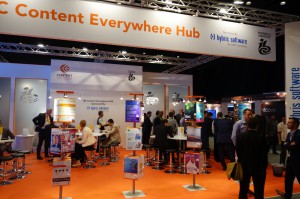Live from IBC’s Content Everywhere MENA: The IP revolution is underway. Are you ready?
Content creators in the MENA region, and in particular Dubai, are taking time this week to come together for Content Everywhere MENA, a new event created by the IBC that is designed to better meet the needs of the international broadcast and content distribution marketplace. The event kicked off with a lively discussion about the future of everything from content creation to distribution and how today’s traditional media players can best address future needs.
Steve Reynolds, CTO of Imagine Communications, kicked off things with a discussion concerning the impact that IP is having on the traditional TV industry.

The Content Everywhere Hub is at the centre of information and knowledge exchange at Content Everywhere MENA in Dubai.
The transition, he says, is more than just moving to a new way of doing old business. Instead it is about reaching a new kind of consumer via new devices that no longer rely on traditional delivery models and instead rely on “unicast” which has an impact on how content is created, produced, and, ultimately, monetized.
“Instead of a broadcast model we are talking about content that is contributed, produced, and distributed out via the cloud to consumers on a one-to-one basis,” he says
More importantly, advertising techniques like personalised ads and real-time audience measurement that has to date been the backbone of broadband advertising is now beginning to migrate to the traditional content delivery methods of broadcast and cable TV.
“How does this change the landscape?,” he asks. “Moving to nonlinear and OTT changes the kind of content and the way consumers engage as they move from passive, lean back and into a much more engaged model. And that is a great thing because you have a more engaged consumer and can ultimately grow the business.”
Reynolds sees five key factors that will help companies come out on top: proper focus on the audience; understanding the way devices change the way consumers access content; understanding how the content should change (long form, short form); how content is distributed and whom to partner with; and finally having the right business model to support the ecosystem.
“Those five factors will determine who wins in this landscape,” he adds.
Enabling those five factors, he says, requires four key components: a software-defined infrastructure that goes beyond baseband; a multi-platform playout environment; a system that is virtualized and can grow as needed; and a system ready for IP-based distribution so it can deliver content as files and packets to whatever devices consumers are using.
That ever-growing list of devices means keeping up with fragmentation becomes a larger challenge, according to Luke Gaydon, Brightcove, VP of Media, EMEA. Budgets, for example, are being consumed to simply keep up with things like content protection.
“It’s a very exciting and complicated time but with lots of opportunity for people in the room today,” he says.
Ingo Lalla, Limelight Networks, MENA regional director, says that the best opportunity for content creators is OTT as it can still mean great consumption of linear TV. Annual global traffic will surpass the zettabyte threshold in 2016 and in 2018 a single person would need more than five million years to watch the amount of video that will cross global IP networks in one month.
OTT will play a key part in that increase in consumption and in the Middle East region sports content will be a major part of the equation.
“Premium content is a challenge here but the chain in OTT is only as good as the weakest link so speed and operability of the network as well as intuitive ways for content discovery are important,” says Lalla. “We are talking about a complex situation to enable things like subscription revenues and extending a brand.”
